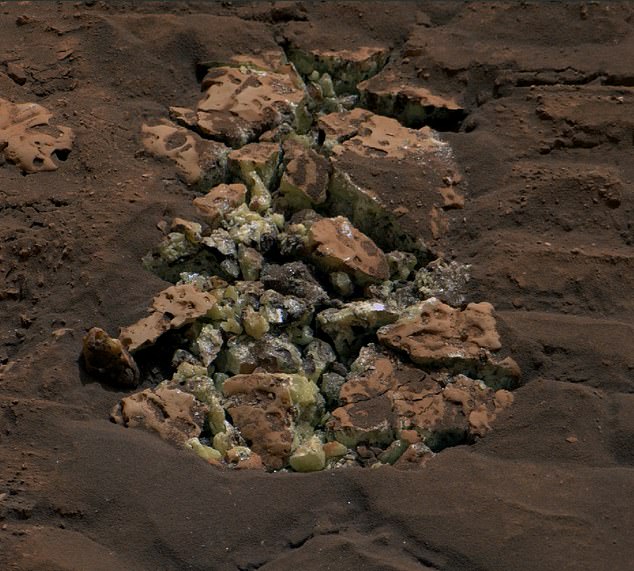NASA’s Curiosity rover has made a “mind-blowing” discovery on Mars that scientists say “shouldn’t be there.”
The one-ton rover discovered yellowish-green crystals of pure sulfur during its search for chemical evidence that the Red Planet was once habitable.
While sulfur-containing minerals have been observed on the Martian world, elemental sulfur has never been seen on its own before.
Curiosity accidentally broke through some white stones while traveling through the Gediz Vallis channel, revealing the “strange” structures that add to growing evidence that Mars was once a habitable world.
The one-ton rover discovered yellowish-green crystals of pure sulfur during its search for chemical evidence that the Red Planet was once habitable.
Previous research has suggested that sulfur may have played a key role in the origin of life on Earth more than four billion years ago, when the atmosphere It was rich in sulfur and carbon, which were emitted through volcanic activity.
The microbes metabolized the sulfur isotopes, releasing oxygen and beginning the process of oxygenation of the atmosphere, known as the Great Oxygenation Event.
But scientists have not said so. Curiosity’s discovery is an indication of past life on Mars.
The discovery adds to growing evidence of other life-supporting elements identified on Mars, including carbon, hydrogen, nitrogen, oxygen and phosphorus.
What the discovery does show is that water flowed on Mars, which is also a key ingredient for life.
Curiosity project scientist Ashwin Vasavada said: ‘Finding a field of stones made of pure sulfur is like finding an oasis in the desert.
“It shouldn’t be there, so now we have to explain it. Discovering strange and unexpected things is what makes planetary exploration so exciting.”
The breakthrough discovery was made May 30 while Curiosity was off-roading inside the Gediz Vallis, a groove that snakes through the three-mile-high Mount Sharp, whose base the rover has been climbing since 2014.
The six-wheeled rover had already detected sulfur on Mars, but only mixed with other minerals such as magnesium and calcium.
When combined with other elements, sulfur emits a pungent odor, but the pure sulfur found on Mars is odorless.
NASA scientists at the Jet Propulsion Laboratory (JPL) in California first identified a collection of white rocks and instructed Curiosity to explore.
The rover sent back to Earth a close-up image of the white stones, which included a portion of crushed rock near Curiosity’s wheels.
And that’s when the team discovered the yellow crystals.
“I think this is the strangest find of the entire mission and the most unexpected,” Vasavada said. CNN.

Curiosity made the strange discovery by accidentally breaking white rocks while traveling through the Gediz Vallis canal.
“I have to say that there is a lot of luck involved here. Not every rock has something interesting inside it.”
Although the sulfur rocks were too small and fragile to be sampled with the drill, a large boulder nicknamed ‘Mammoth Lakes’ was detected nearby.
Rover engineers had to find a patch of rock that would allow for safe drilling and find a place to park on the loose, sloping surface.
After Curiosity drilled its 41st hole using the powerful drill located on the end of the rover’s two-meter (6.7-foot) robotic arm, the six-wheeled scientist dropped the powdered rock into instruments inside its belly for further analysis so scientists could determine what materials the rock is made of.
“Nobody had pure sulfur on their bingo card,” Vasavada said.
Sulfur rocks typically have a “beautiful, translucent, crystalline texture,” the scientists explained.
But the clump seen on Mars had been sandblasted over millions of years, dulling its bright yellow and making it appear reddish like the surrounding landscape.
However, the find adds to growing evidence of other life-supporting elements identified on Mars, including carbon, hydrogen, nitrogen, oxygen and phosphorus.
The Gediz Vallis channel is one of the main reasons the scientific team wanted to visit this part of Mars. The region is located just south of the Martian equator.
Scientists believe the channel was carved out by flows of liquid water and debris, which left a two-mile expanse on the mountainside beneath the channel.
The goal has been to develop a better understanding of how this landscape changed billions of years ago, and recent clues have provided insight.
Since Curiosity arrived at the canal earlier this year, scientists have studied whether ancient floods or landslides formed the large mounds of debris that rise from the bottom of the canal.

The rover sent back to Earth a close-up image of the white stones, which included a layer of crushed rock near Curiosity’s wheels. That’s when the team spotted the yellow crystals.
Curiosity’s latest clues suggest both factors played a role: Some mounds were likely left by violent flows of water and debris, while others appear to be the result of more local landslides.
These conclusions are based on rocks found in the debris mounds. While the stones carried by the water flow take on a rounded shape like river rocks, some of the debris mounds are riddled with more angular rocks that may have been deposited by dry avalanches.
Eventually, the water filtered out all the material that had settled here. Chemical reactions caused by the water bleached some of the rocks, forming halos. Erosion caused by wind and sand has revealed these halos over time.
“This was not a quiet period on Mars,” said Becky Williams, a scientist at the Planetary Science Institute in Tucson, Arizona, and deputy principal investigator for Curiosity’s Mast Camera.
“There has been very intense activity here. We are seeing multiple flows along the channel, including vigorous flooding and boulder-heavy flows.”


